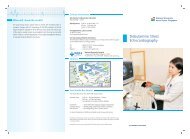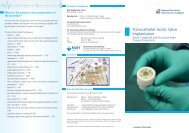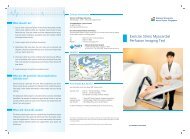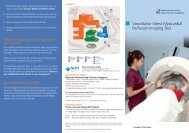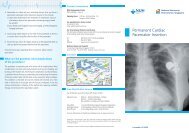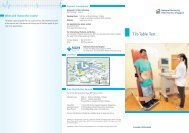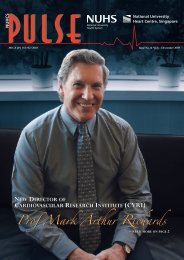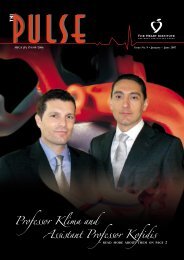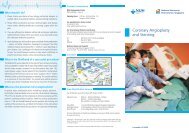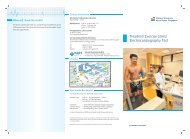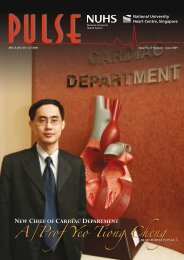Prof Chia Boon Lock receives the SMA Honorary ... - nuhcs
Prof Chia Boon Lock receives the SMA Honorary ... - nuhcs
Prof Chia Boon Lock receives the SMA Honorary ... - nuhcs
You also want an ePaper? Increase the reach of your titles
YUMPU automatically turns print PDFs into web optimized ePapers that Google loves.
1. Identify disease susceptibility polymorphisms for AF using<br />
candidate gene association analysis<br />
2. Define interaction of genetic factors with acquired factors in<br />
modifying AF risk and phenotypic expression<br />
3. Pave <strong>the</strong> way toward establishing a larger cohort to facilitate<br />
genome-wide association analysis in <strong>the</strong> future<br />
With preliminary data derived from this cohort of lone AF<br />
patients, I successfully obtained a National Medical Research Council<br />
grant that will support this research effort for <strong>the</strong> next three years.<br />
Presently, approximately 100 lone AF patients have been enrolled;<br />
I anticipate <strong>the</strong> enrollment process will be accelerated through<br />
collaboration of colleagues in National Heart Center and Tan Tock<br />
Seng Hospital. In addition, mutation scanning of candidate genes<br />
such as potassium and sodium channel genes is underway.<br />
This project would not have been possible if it was not<br />
for <strong>the</strong> support of <strong>the</strong> following: Chief, Cardiac Department,<br />
NUH, Assoc <strong>Prof</strong> Tan Huay Cheem; Head, Department of<br />
Medicine, NUS, <strong>Prof</strong> Ho Khek Yu; my mentors, <strong>Prof</strong> <strong>Chia</strong> and<br />
Assoc <strong>Prof</strong> Ling; colleagues in <strong>the</strong> Cardiac Department, NUH;<br />
research nurses, Ms. Quay Chwee Neo and Ms. Loh Fong Chee;<br />
collaborators in National Heart Center and Tan Tock Seng<br />
Hospital; <strong>the</strong> Yong Loo Lin School of Medicine and <strong>the</strong> National<br />
Medical Research Council. Ultimately, <strong>the</strong> success of this project<br />
will not only advance our understanding of a significant<br />
cardiovascular disease, but also underscore <strong>the</strong> feasibility and<br />
importance of multi-center collaboration in Singapore.<br />
CIT Beijing meetingDr Adrian<br />
Low, Cardiac Dept @ NUH<br />
CIT Beijing 2008 (China<br />
Interventional Therapeutics,<br />
Beijing) is an annual major<br />
meeting for interventional<br />
cardiologists. It was held this year<br />
from 19 to 23 March at <strong>the</strong> Beijing<br />
Interventional Convention Center.<br />
We were privileged to be given an<br />
opportunity for live-transmission<br />
to showcase our interventional techniques.<br />
The live-transmission was held on <strong>the</strong> morning of <strong>the</strong> 2nd<br />
day (20th March). We had 2 teams on hand: <strong>Prof</strong> Tan Huay Cheem<br />
and Dr Lim Ing Haan; Dr Adrian Low and <strong>Prof</strong> Ronald Lee. As was<br />
traditional, <strong>the</strong>re was an introductory segment to Singapore; fusing<br />
a blend of Singapore skyline, cultural activities, and images of our<br />
esteemed interventionists, to a pulsating soundtrack. The montage<br />
was expertly executed, earning praises even from professional media.<br />
<strong>Prof</strong> Tan started <strong>the</strong> live-transmission with a case of “instent<br />
restenosis”. This patient had had previous stenting to <strong>the</strong> heart<br />
artery but returned because of re-narrowing of <strong>the</strong> same segment.<br />
This was addressed with a novel drug-eluting balloon. This balloon<br />
is coated with a medication that inhibits recurrent renarrowing of<br />
<strong>the</strong> heart artery and has been shown in a recent published study to<br />
be effective at least in patients with narrowing of <strong>the</strong> leg arteries.<br />
The blockage was expertly cleared and treated with this new device<br />
with good results. In contrast to <strong>the</strong> usual placement of ano<strong>the</strong>r<br />
medicated stent, this approach does away<br />
with deploying an additional metal coat<br />
which may have deleterious consequences.<br />
The second case was an<br />
intervention of a saphenous vein graft.<br />
Traditionally, this is addressed using a distal<br />
protection device, ei<strong>the</strong>r a filter wire or<br />
balloon occlusion device, to catch <strong>the</strong><br />
anticipated downstream flow of clots and<br />
o<strong>the</strong>r debritus. We however demonstrated <strong>the</strong> safety and efficacy of<br />
a new proximal protection device. This was a special ca<strong>the</strong>ter with<br />
an inflatable balloon at its tip that can be inflated to seal off <strong>the</strong><br />
saphenous vein graft, <strong>the</strong>reby preventing flushing of debris<br />
downstream. An advantage of this is <strong>the</strong> virtual protection from all<br />
embolism, even with initial passage of our guide wire across <strong>the</strong><br />
blockage. This case was similarly well received. In addition, it was <strong>the</strong><br />
first time that a live-transmission of such as device was demonstrated<br />
regionally. The audience’s curiosity was obviously piqued.<br />
As usual, <strong>the</strong>re was <strong>the</strong> usual banter by <strong>the</strong> chairperson<br />
and o<strong>the</strong>r prominent interventional cardiologists. Our doctors<br />
joined in <strong>the</strong> spirited exchange and responded well to <strong>the</strong> variety<br />
of questions fielded. The teams enjoyed <strong>the</strong>mselves doing difficult<br />
cases under <strong>the</strong> glare of <strong>the</strong> media, and <strong>the</strong> live-transmission was<br />
all too soon over. As <strong>the</strong> day came to a close, <strong>Prof</strong> Tan made his<br />
sojourn to Beijing, representing our interventional cardiology team<br />
and of course NUH.<br />
THI PULSE | 15



